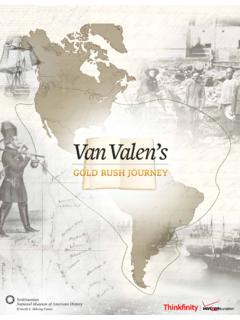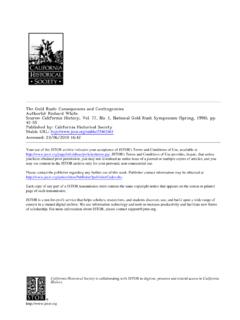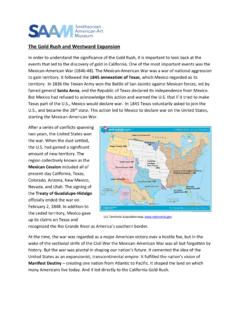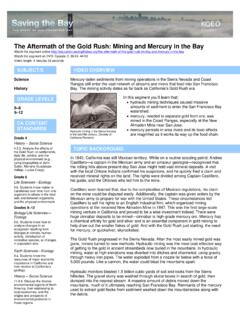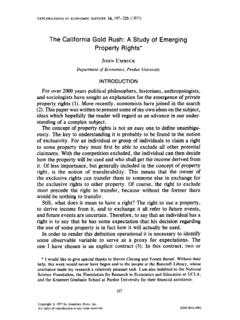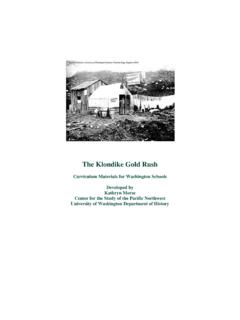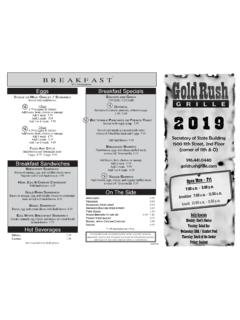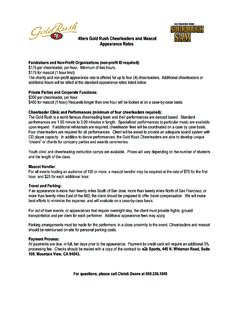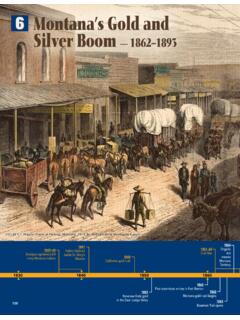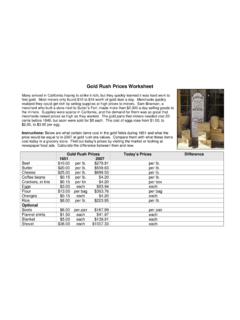Transcription of Summary
1 Summary This interactive project allows students to perform the work of a historian as they explore the journal of Alexander Van Valen, a 30-year-old New York man who set sail in 1849 to stake his claim in the California gold fields. The project provides a rich set of primary sources to investigate and analyze the gold rush era and the lives of forty-niners. It focuses on the questions, Why did they go? and What was it like? . The activity has two major components, an interactive Web site called Van Valen's gold rush Journey (http://americanhistory. ), and a student worksheet ( ), which serves as both a companion guide and worksheet for students.
2 Students will download the student worksheet, then use the primary sources on the Web site to answer historical questions about Van Valen's journal entries/letters (there are seven entries in total). The output of the project (the student worksheet) is a high- quality Adobe Acrobat PDF file that students can save, edit, and print for use as a final project for grading. The project can be used as a tool to engage students in historical thinking as part of your unit on Westward Expansion. Objectives Students will be better able to: 1. apply historical thinking, analysis, and interpretation to answer historical questions.
3 2. understand the settlement of the West. Page 1. Time Two class periods and project work at home w Project Kickoff Class 50 minutes/ 1 class period w Students Complete Entries 2 to 7 15-30 minutes per entry (home/lab work). w Students Create Final Journal Entry 30 minutes (homework). w Project Wrap-up Class 50 minutes/ 1 class period Grade Level 6th 12th grade Vocabulary A number of nautical terms are included in the primary source documents. Here is a good basic resource for nautical terms: http://. Students should be encouraged to have a dictionary on hand to look up unfamiliar words as they analyze the primary sources.
4 Note: Van Valen's journal entries are direct transcriptions of his original words, spelling and punctuation, so there are numerous typographical and grammatical errors. In most cases they do not prevent clear understanding of a passage. Coach students to read aloud any sections with which they are having trouble. Van Valen's errors are quickly clarified when spoken aloud. Materials w Computer with Internet access (Flash plug-in & Adobe Reader). w Van Valen's gold rush Journey Web Site (http://. ). Page 2. w Van Valen's gold rush Journey Instruction Sheet (Appendix A). w Student Worksheet PDF ( onthewater/goldrush/assets/pdf/goldrush_ studentactivity.)
5 Pdf) (print or digital). w Journal Entries Transcript ( onthewater/goldrush/assets/ ). w Dictionary w Printer (recommended). Preparation Project Kickoff Class w Visit the Van Valen's gold rush Journey Web site to preview it and download the Student Worksheet. Print copies of the Student Worksheet for students to use as a guide and for note taking as you orient them to the Web site. The student worksheet PDF file is interactive, so students should be given the digital PDF file for producing their final projects. w Print copies of the Van Valen's gold rush Journey Instruction Sheet for students (Appendix A).
6 Note: Teachers may want to review the California by Sea section of the main On the Water Web site to note the gold rush 's impact on people and the land in the wider context of Westward Expansion. http://. html Project Wrap-up Class w Plan to have the Van Valen's gold rush Journey Web site on screen for class discussion. w Board or flipchart to record student responses. w Ask students' to bring their completed Student Worksheets to class. w Print What Smithsonian Curators Learned About the Van Valens information sheet for students (Appendix C). w Print gold rush Rubric (Appendix B). Page 3. Standards Era 4 - Expansion and Reform (1801-1861).
7 Standard 2E - The student understands the settlement of the West. Standard 1: Chronological Thinking A. Distinguish between past, present, and future time. B. Identify the temporal structure of a historical narrative or story. C. Establish temporal order in constructing historical narratives of their own. D. Measure and calculate calendar time. Standard 2: Historical Thinking A. Identify the author or source of the historical document or narrative and assess its credibility. B. Reconstruct the literal meaning of a historical passage. C. Identify the central question(s) the historical narrative addresses.
8 D. Differentiate between historical facts and historical interpretations. E. Read historical narratives imaginatively. F. Appreciate historical perspectives. G. Draw upon data in historical maps. H. Utilize visual, mathematical, and quantitative data. Standard 3: Historical Analysis & Interpretation A. Compare and contrast differing sets of ideas. B. Consider multiple perspectives. C. Analyze cause-and-effect relationships and multiple causation, including the importance of the individual, the influence of ideas. E. Distinguish between unsupported expressions of opinion and informed hypotheses grounded in historical evidence.
9 H. Hold interpretations of history as tentative. Page 4. Standard 4: Historical Research Capabilities A. Formulate historical questions. B. Obtain historical data from a variety of sources. C. Interrogate historical data. D. Identify the gaps in the available records, marshal contextual knowledge and perspectives of the time and place. E. Employ quantitative analysis. F. Support interpretations with historical evidence. Bibliography html Page 5. Project Kickoff Class 1. Introduce the topic and project to students (See Introduction below). 2. Hand out copies of the Instruction Sheet and Student Worksheet 3.
10 Walk students through the Instruction Sheet using the Interactive Web site to orient them to the Web site's functions and layout 4. Model historical thinking while completing the questions for Day 1 of the journey together as a class, Students should write the answers for Day 1 on their printed student worksheet 5. Review project requirements Introduction The gold rush drew wealth-seekers from around the world. More than a third came by sea. Glittering rumors of gold for the taking spread from California around the globe beginning in 1848. Tens of thousands of people left homes and families to chase the dream of quick riches.
